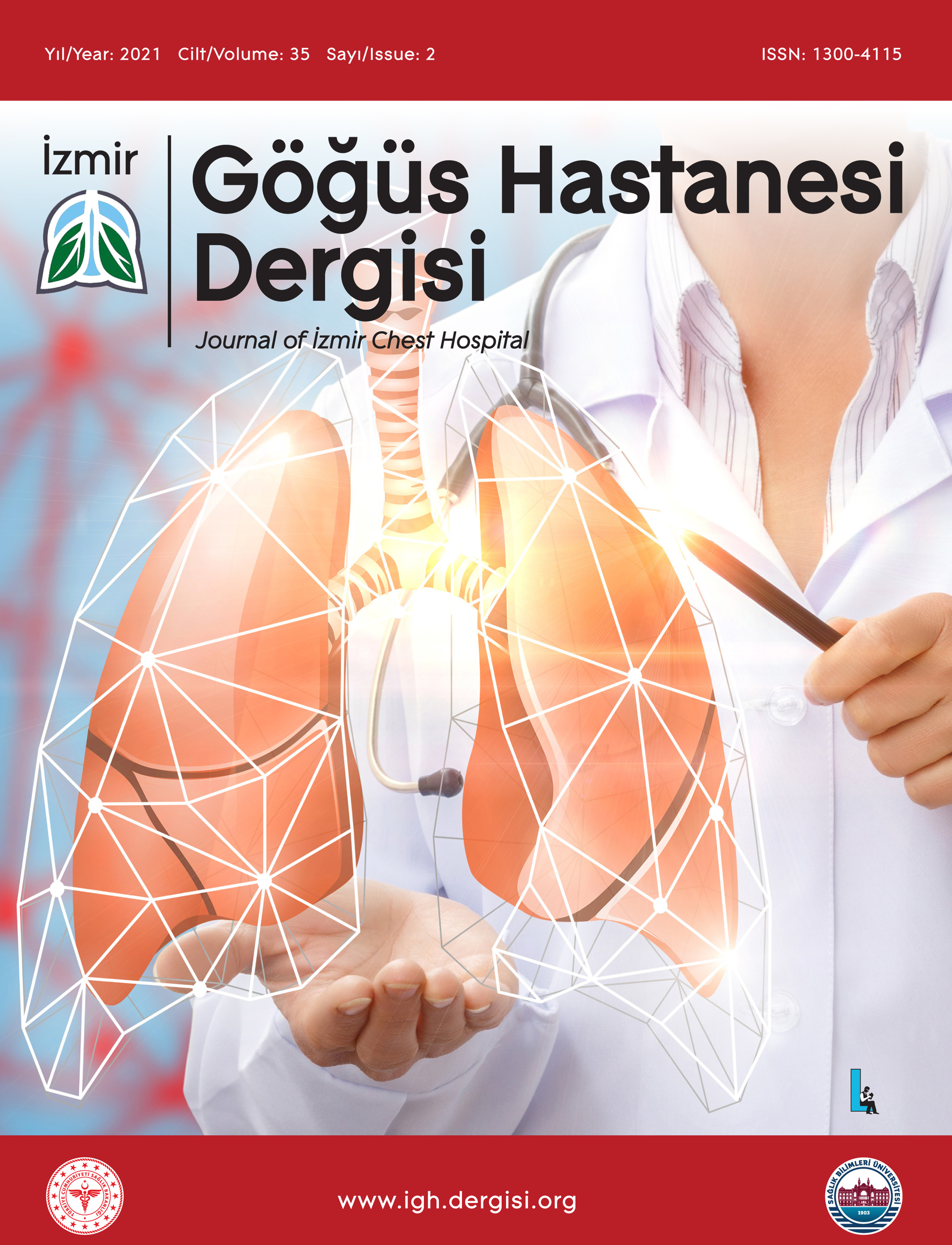Göğüs Hastalıkları Onkolojik Acillerin Değerlendirilmesi
Dursun Tatar1, Ceyda Anar1, Yasemin Özdoğan1, Enver Yalnız1, Ali Kadri Çırak1, Ahmet Emin Erbaycu21İzmir Dr Suat Seren Göğüs Hastalıkları ve Cerrahisi Eğitim ve Araştırma Hastanesi, Göğüs Hastalıkları, İzmir, Türkiye2İzmir Bakırçay Üniversitesi Tıp Fakültesi, Göğüs Hastalıkları Anabilim Dalı
GİRİŞ ve AMAÇ: Göğüs hastalıkları hastanesi acil servisine başvuran onkoloji hastalarının genel özelliklerini ortaya koymak amaçlandı
YÖNTEM ve GEREÇLER: Bir aylık dönemde acil servise başvuran malignite tanılı hastaların sosyodemografik verileri ile birlikte başvuru semptomları ve acil tanıları retrospektif olarak incelendi.
BULGULAR: Çalışmaya alınan 118 hastanın 105 (%84.7)si erkek, 13 (%15.3)ü kadın ve yaş ortalaması 61.2 yıl idi. En sık başvuru yapan yaş aralığı 50-59 idi. Hastalarımızda saptanan en sık semptomlar nefes darlığı (%50), ağrı (%27.9), ateş (%14.4) ve hemoptizi (%10.1) idi. Daha az sıklıkta bulantı (%9.3), öksürük-balgam çıkarma (%7.6) ve halsizlik (%5.9) izlendi. Küçük hücreli dışı akciğer karsinomlu hastaların %87.5i ve küçük hücreli akciğer karsinomunun %23.5i ileri evre kansere sahip idi. En sık rastlanan acil tanı 49 (%41.5) hastada solunum yetmezliği, 14 (%11.8) hastada kemik metastazı, 13 (%11) hastada beyin metastazı idi.
TARTIŞMA ve SONUÇ: Göğüs hastalıkları acil servisine başvuran hastaların en sık yakınmaları nefes darlığı ve ağrı, en sık acil tanıları solunum yetmezliği ve metastatik hastalıktır. Genel talep palyatif tedaviler içindir, ölüm oranı düşüktür.
The Assessment of Oncological Emergencies Of Chest Diseases
Dursun Tatar1, Ceyda Anar1, Yasemin Özdoğan1, Enver Yalnız1, Ali Kadri Çırak1, Ahmet Emin Erbaycu21Health Sciences University School of Medicine, Izmir Suat Seren Thoracic Diseases and Surgery Center, The Department of Thoracic Diseases2Izmir Bakircay University School of Medicine, The Department of Thoracic Diseases
INTRODUCTION: It was aimed to reveal the general characteristics of oncology patients referred to emergency service of chest diseases training hospital.
METHODS: A retrospective analysis was performed on the socio-demographic data, the referral symptoms and emergency diagnoses of the subjects diagnosed with malignity who referred to emergency service along one month.
RESULTS: Of 118 subjects included in the study, 13 (84.7 %) were women and 105 (84.7 %) were men and the average age was 61.2 years. Frequent age interval was between 50-59. The symptoms most often seen in our cases were dypnea (50 %), pain (27.9 %), fever (14.4 %) and hemoptysis (10.1 %), whereas nausea (9.3%), cough-expectoration (7.6%) and weakness (5.9%) were observed less frequently. 87.5% of non-small cell lung carcinoma and 23.5% of small cell lung carcinoma had advanced stage lung cancer. The most frequent encountered emergency diagnoses were respiratory insufficiency in 49 (41.5%) cases, bone metastasis in 14 (11.8%) and brain metastasis in 13 (11%).
DISCUSSION AND CONCLUSION: It was observed that the most frequent complaints for emergency deferral were dyspnea and pain and the most frequent emergency diagnoses were respiratory insufficiency and metastatic disease. General requirement was for palliative treatments and the mortality was lower.
Makale Dili: Türkçe






